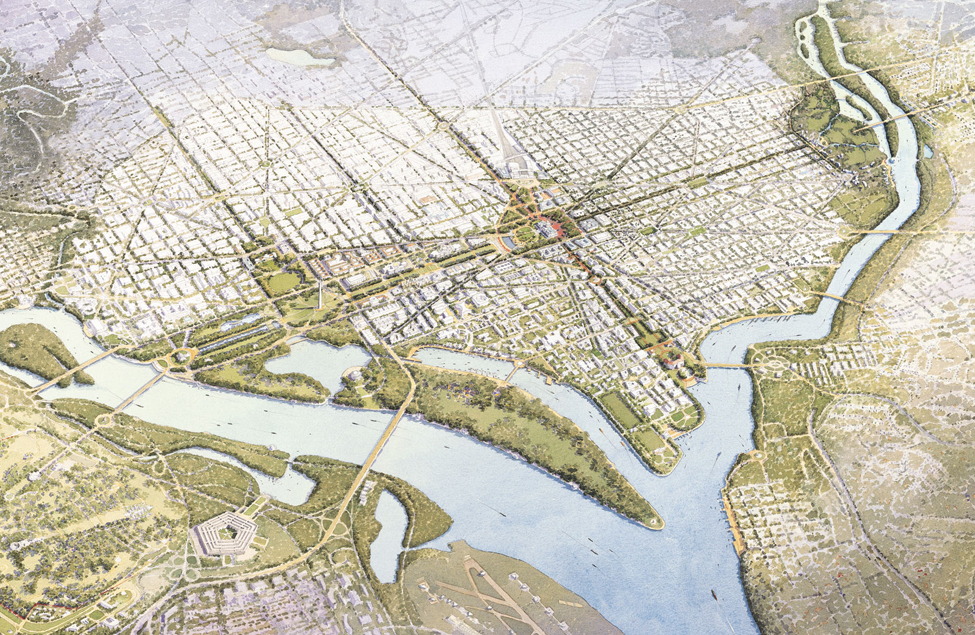
- By Stephen Staudigl
- November 22, 2017
Happy 20th Legacy!
In November 1997, NCPC published Extending the Legacy: Planning America’s Capital for the 21st Century. The Legacy Plan, or Legacy, as it’s affectionately known, is NCPC’s visionary planning document designed as the third act in the Washington, DC planning story, following upon the L’Enfant (1791) and McMillan (1902) Plans. It is a “big picture” plan that aims to redefine Washington’s monumental core beyond downtown and the National Mall. In honor of its 20-year anniversary, we take a look at some of the ways the plan has influenced the capital’s development.
A Visionary Plan
Legacy is a vision plan, painting in broad-brush strokes that focus on overarching themes and concepts more than detailed development proposals. The result of several years of NCPC-led work with input from local government representatives, other federal agencies, nationally renowned architects and urban designers, and Americans from across the country, it offered a vision for Washington over the next 50-100 years. Themes include recentering the city on the U.S. Capitol, redeveloping Washington’s waterfronts, creating new development opportunities in all four quadrants, and providing improved connectivity and transportation in and around the city.
Legacy’s Impact
As with any visionary plan, it takes many partners to make vision become reality. NCPC’s plan sought to use federal development to support local development and revitalization goals, and twenty years after its introduction, we’re seeing implementation of many of Legacy’s ideas through the work of federal, local, and private entities.
The federal government led the way by locating agencies into new areas of the city beyond the traditional core. The U.S. Department of Transportation, constructed at the former Southeast Federal Center, opened in 2007 and jump-started the area’s transformation into the vibrant Capitol Riverfront neighborhood. In northeast, the Bureau of Alcohol, Tobacco, Firearms and Explosives headquarters, completed in 2008, played an important role in the development of the now burgeoning NoMa (North of Massachusetts Avenue) neighborhood. The Department of Homeland Security is consolidating offices and its headquarters to the former St. Elizabeths West Campus in Anacostia, where the influx of offices and workers is anticipated to have a positive impact on the surrounding area.
Legacy also shaped the city’s commemorative landscape. NCPC’s Memorials and Museums Master Plan (2001), a direct offshoot of Legacy, guided the siting of five memorials in locations beyond the National Mall and introduced the concept of a Reserve (“no-build” zone) on the National Mall, which Congress gave the power of law in 2003. The Monumental Core Framework Plan (2009) provided more in-depth analysis and tools to advance Legacy's goals to relieve development pressure on the National Mall by transforming adjacent predominantly federal precincts into vibrant, exciting destinations better integrated into city life.
Legacy’s vision to reconnect Washington to its rivers, and connect the waterfront, is also well underway. The Anacostia Riverfront Initiative, led by the District government with the support of federal and regional partners, continues to pursue a clean river, inviting waterfront destinations, and infrastructure that connects communities. The expanding Anacostia Riverwalk Trail today provides opportunities to stroll along one of the city’s great and underutilized resources. Capitol Riverfront is a bustling and energized neighborhood with offices, shops, restaurants, housing, and stadiums. Canal Park and The Yards Park provide lovely green space along, and near, the water. Georgetown Waterfront Park—achieved through the combined efforts of local citizens, the National Park Service, and the District government—sits on a former industrial site and parking lot, where visitors now enjoy views of the Potomac River and a respite from the Georgetown bustle. Construction is underway to achieve Legacy’s aim to connect the Kennedy Center to the Potomac River and the Rock Creek Paved Recreation Trail.
Legacy’s goal of a rejuvenated South Capitol Street is unfolding today. In addition to the nearby projects previously mentioned, the city’s efforts to improve streetscapes, combined with the Nationals and DC United stadiums and adjacent development, are transforming the corridor into one that we can all be proud of.
What’s Next?
Twenty years after its introduction Legacy continues to be a landmark guidance document for NCPC and others as Washington, DC continues to grow and develop as a great capital city.
While today’s Washington is very different than the one into which NCPC introduced Legacy in 1997—including changes in how we live, work, and get around—its impact continues to be felt. Legacy envisioned transforming the RFK Stadium site at the end of East Capitol Street on the Capitol’s eastern radius, and removing it’s sea of asphalt. NCPC’s follow-up RFK Stadium Site Study proposed further details, and EventsDC recently unveiled a new concept plan for the site.
Legacy may not have contemplated ridesharing or autonomous vehicles, but it thought about how we might use totally different kinds of transportation in the future. Those who enjoy the ever-expanding DC Circulator can thank the Legacy Plan, which originally proposed the creation of an inexpensive transportation option to provide increased connectivity in the monumental core. The development of water taxis—also a Legacy recommendation—is seeing increased interest. Plans for the new Frederick Douglass Memorial Bridge and the 11th Street Bridge Park provide striking designs, “destination” public spaces, and new connections.
As Legacy moves into its next decade NCPC can say that we are pleased with its impact so far, and will continue to work with federal, local, and other partners to use its vision in planning our capital city. Thank you Legacy, and all the best as you move into your twenties!
The Legacy Plan


